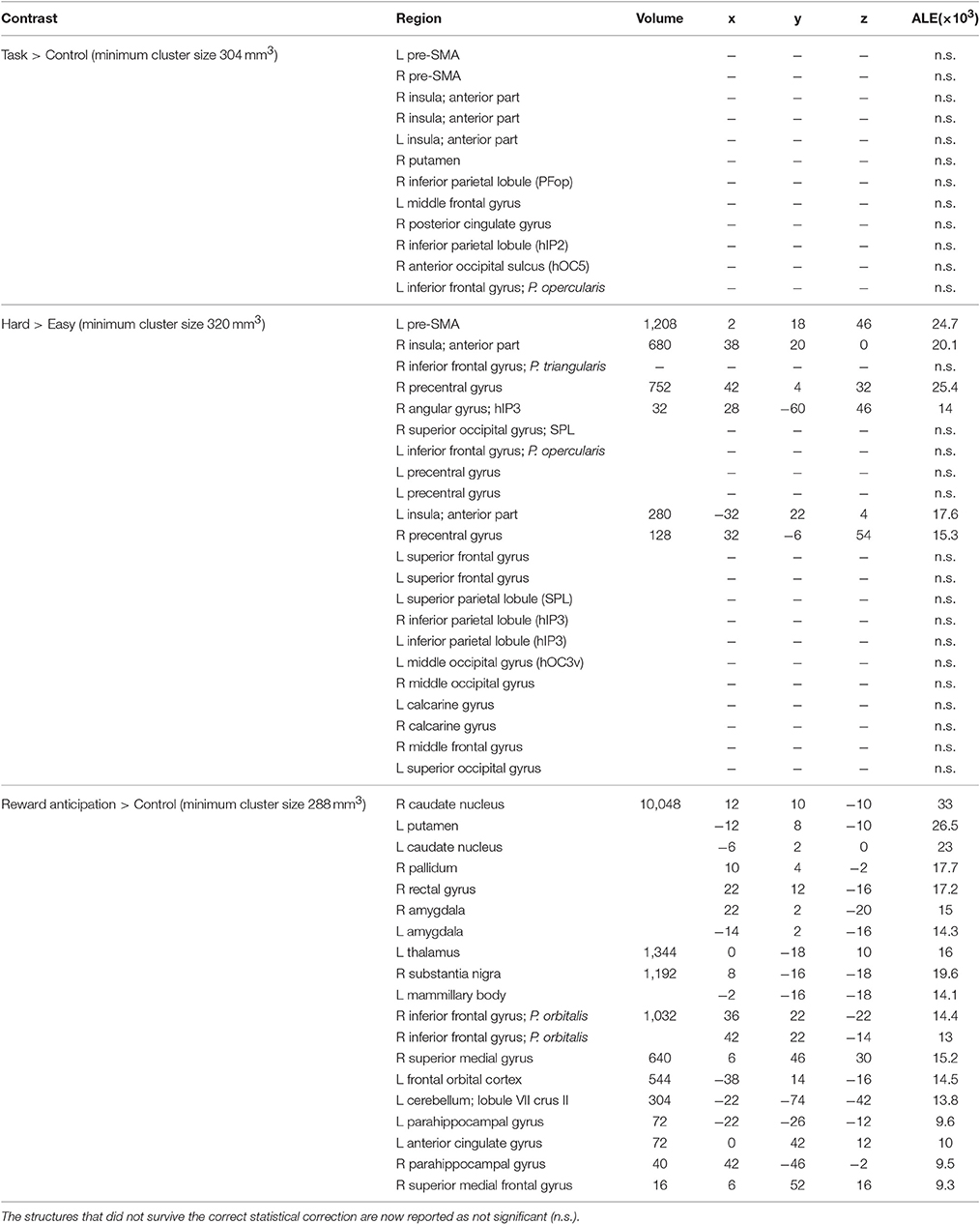- 1Faculty of Social and Behavioural Science, Cognitive Science Center Amsterdam, University of Amsterdam, Amsterdam, Netherlands
- 2Max Planck Institute for Human Cognitive and Brain Sciences, Leipzig, Germany
- 3Institute of Clinical Neuroscience and Medical Psychology, Heinrich Heine University Düsseldorf, Düsseldorf, Germany
- 4Research Centre Jülich, Institute of Neuroscience and Medicine (INM-1), Jülich, Germany
- 5Leipzig University Medical Center, IFB Adiposity Diseases, Leipzig, Germany
A corrigendum on
Brain networks of perceptual decision-making: an fMRI ALE meta-analysis
by Keuken, M. C., Müller-Axt, C., Langner, R., Eickhoff, S. B., Forstmann, B. U., and Neumann, J. (2014). Front. Hum. Neurosci. 8:445. doi: 10.3389/fnhum.2014.00445
Introduction
Recently, Eickhoff et al. (2017) reported that the software version of GingerALE (2.3 http://brainmap.org/ale/) which was used for our meta-analysis published in Keuken et al. (2014) contained several severe implementation errors regarding the multiple-comparison correction. These errors resulted in a more liberal statistical threshold than was specified by the authors. With the newest release of GingerALE (2.3.6), these implementation errors should be remedied.
Methods
In line with the recommendation by Eickhoff et al. (2017) and following the example by Smith and Delgado (2017) we re-analyzed the original data implementing the corrected multiple-comparison correction using GingerALE (2.3.6). All other statistical parameters were identical to those previously reported in Keuken et al. (2014). As expected, when applying a more stringent threshold, the major change in results pertains to a reduction in the number of significant clusters that survived correction for multiple comparisons. Here, we report results of our re-analysis, providing an adjusted original Table 4, indicating which clusters did not survive the correct statistical threshold (see Table 4).

Table 4. The original Table 4 of Keuken et al. (2014) adjusted for the correct statistical multiple comparison implementation.
Results
For the contrast Task > Control condition, no clusters survived the multiple-comparison correction.
For the contrast Hard > Easy condition, the right pre-supplementary motor area (pre-SMA), right pre-central gyrus, right angular gyrus (hIP3) and the bilateral anterior insula were the only clusters that remained significant after correction. The biggest change was that there was no cluster in the inferior frontal gyrus (IFG), superior frontal gyrus, and occipital lobe.
For the contrast Reward Anticipation > Control condition there was no change in the reported clusters.
Given that there were no surviving clusters for the Task > Control contrast, the conjunction analysis as reported in the original Table 5 is non-informative.
Discussion
It was surprising that the Task > Control analysis with 11 incorporated experiments resulted in no surviving clusters. The Hard > Easy condition with 13 incorporated experiments, and Reward anticipation > Control condition with 14 incorporated experiments replicate most, if not all, previously found clusters. This did not seem to be driven by the initially reported cluster size as the original Task > Control analysis reported similar cluster volumes as the other two analyses.
The changes in results should also be seen in light of recent recommendations of sample size in coordinate-based meta-analyses (Eickhoff et al., 2016). To have sufficient power for moderate effects it is recommended to include a larger number of experiments in a given contrast than we included.
Conclusion
The original conclusion regarding a task-general network for perceptual decision-making is no longer warranted based on the corrected results in the Task > Control analysis. It thus remains an open question whether the lack of significant convergence is just a matter of limited power or whether there simply is no common network involved across the various included paradigms taxing perceptual decision-making.
To allow others to re-analyze our results and to incorporated additional experiments for sufficient statistical power, we have uploaded the raw input files. The data can be found on (https://app.box.com/s/v974c7fdo6r1o89vjy96tuktyw170ol3).
Conflict of Interest Statement
The authors declare that the research was conducted in the absence of any commercial or financial relationships that could be construed as a potential conflict of interest.
References
Eickhoff, S. B., Laird, A. R., Fox, P. M., Lancaster, J. L., and Fox, P. T. (2017). Implementation errors in the GingerALE Software: description and recommendations. Hum. Brain Mapp. 38, 7–11. doi: 10.1002/hbm.23342
Eickhoff, S. B., Nichols, T. E., Laird, A. R., Hoffstaedter, F., Amunts, K., Fox, P. T., et al. (2016). Behavior, sensitivity, and power of activation likelihood estimation characterized by massive empirical simulation. NeuroImage 137, 70–85. doi: 10.1016/j.neuroimage.2016.04.072
Keuken, M. C., Müller-Axt, C., Langner, R., Eickhoff, S. B., Forstmann, B. U., and Neumann, J. (2014). Brain networks of perceptual decision-making: an fMRI ALE meta-analysis. Front. Hum. Neurosci. 8, 1–14. doi: 10.3389/fnhum.2014.00445
Keywords: decision-making, meta-analysis, fronto-parietal-basal ganglia, corrigendum, GingerALE
Citation: Keuken MC, Müller-Axt C, Langner R, Eickhoff SB, Forstmann BU and Neumann J (2017) Corrigendum: Brain networks of perceptual decision-making: an fMRI ALE meta-analysis. Front. Hum. Neurosci. 11:139. doi: 10.3389/fnhum.2017.00139
Received: 09 November 2016; Accepted: 09 March 2017;
Published: 22 March 2017.
Edited by:
Aron K. Barbey, University of Illinois at Urbana–Champaign, USAReviewed by:
Aron K. Barbey, University of Illinois at Urbana–Champaign, USAMatthew J. Sutterer, University of Iowa, USA
Copyright © 2017 Keuken, Müller-Axt, Langner, Eickhoff, Forstmann and Neumann. This is an open-access article distributed under the terms of the Creative Commons Attribution License (CC BY). The use, distribution or reproduction in other forums is permitted, provided the original author(s) or licensor are credited and that the original publication in this journal is cited, in accordance with accepted academic practice. No use, distribution or reproduction is permitted which does not comply with these terms.
*Correspondence: Max C. Keuken, bWNrZXVrZW5AZ21haWwuY29t
 Max C. Keuken
Max C. Keuken Christa Müller-Axt
Christa Müller-Axt Robert Langner
Robert Langner Simon B. Eickhoff3,4
Simon B. Eickhoff3,4 Birte U. Forstmann
Birte U. Forstmann Jane Neumann
Jane Neumann